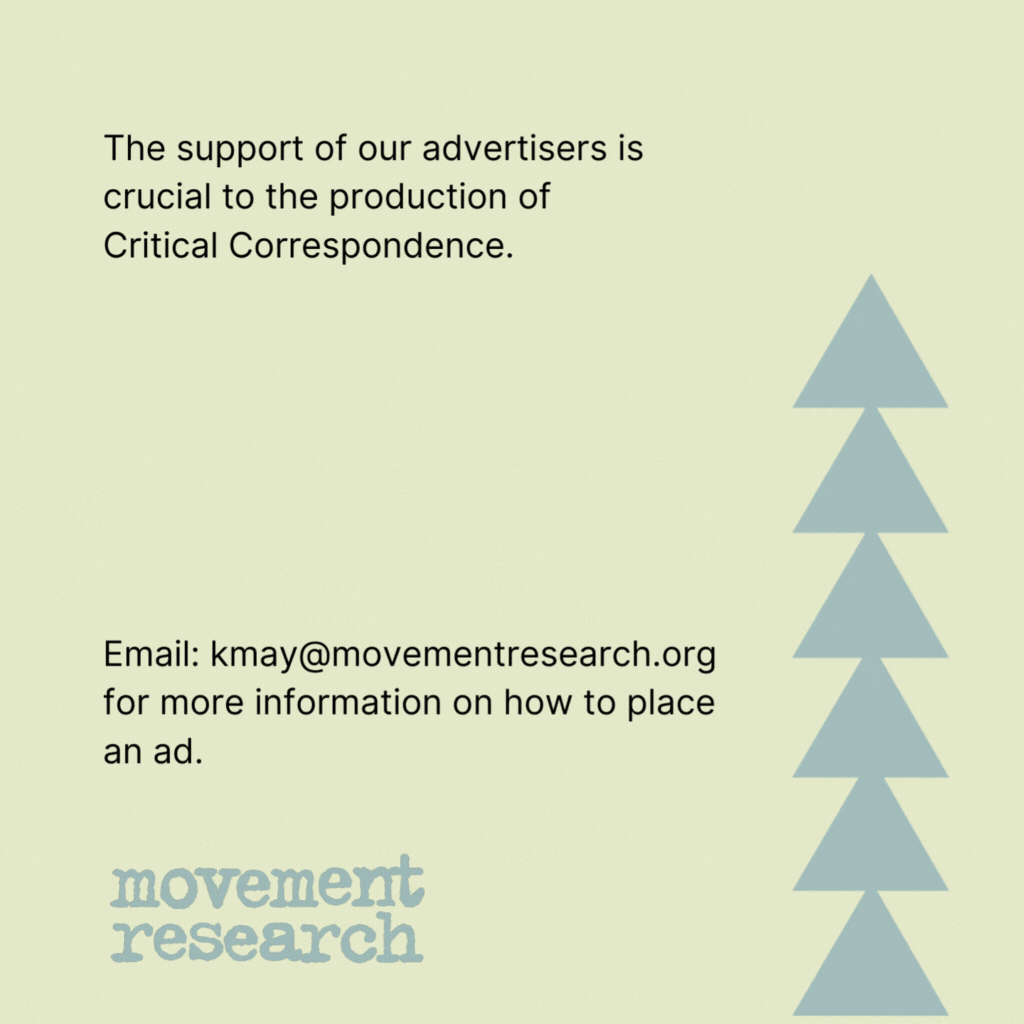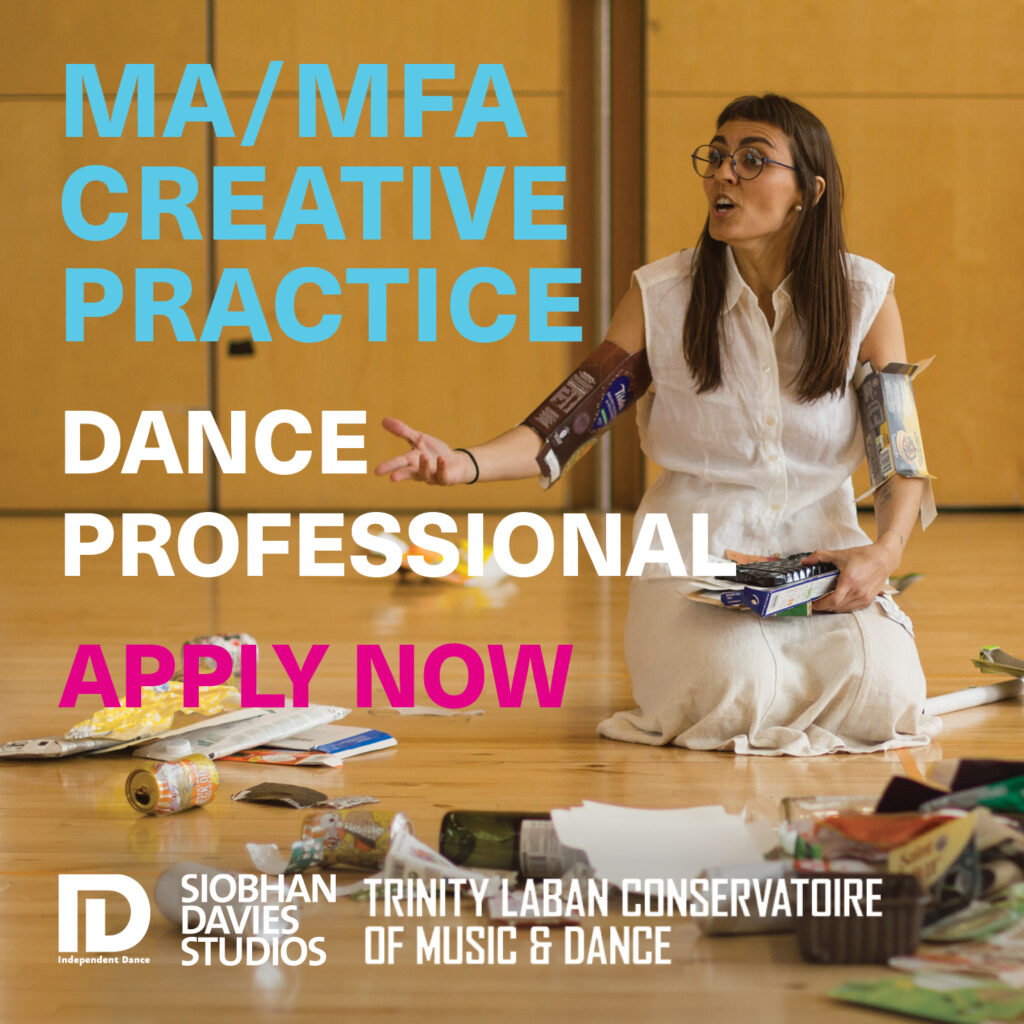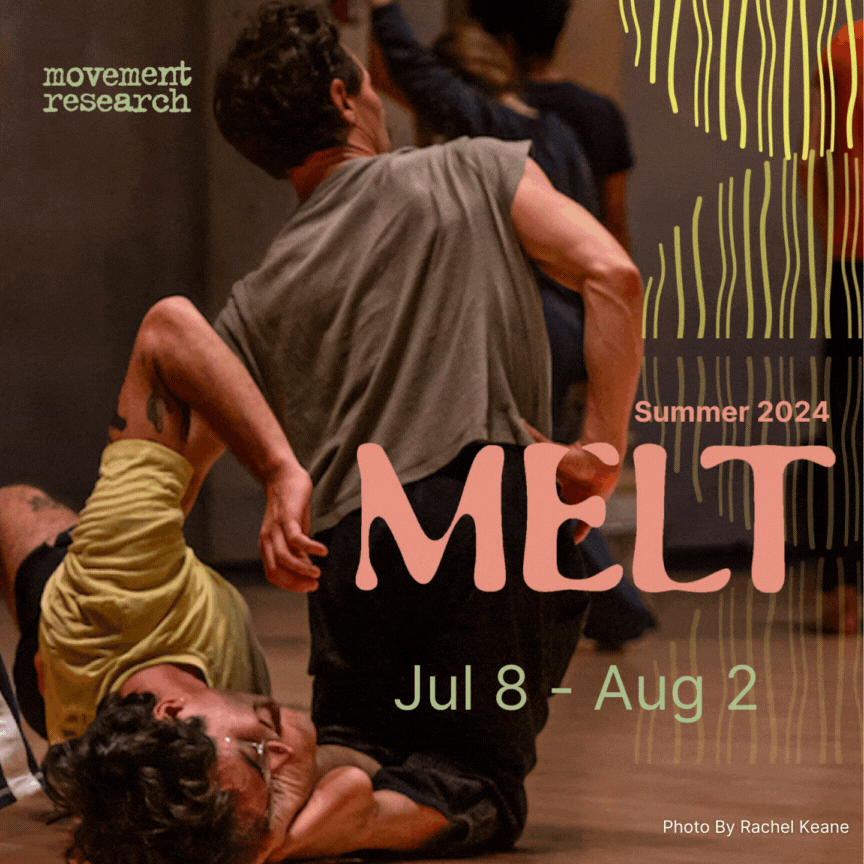CC intern Lizzie Feidelson reflects on the relationship between dance and writing during a (Soma)tic Poetry Workshop, a movement-based writing workshop conducted by Philadelphia-based poet CAConrad in May 2012 as part of Movement Research’s 2012 festival: Push It. Real. Good. CAConrad is a 2011 PEW Fellow, a 2012 RADAR Fellow, 2012 UCROSS Fellow, and a 2013 BANFF Fellow. His latest book, A Beautiful Marsupial Afternoon: New (Soma)tics, was published by Wave Books in April 2012.
Download a PDF of this writing.
The poet CAConrad generates his poems through physical practice: (Soma)tic Poetry Exercises, made-up rituals that require him to eat one color of food each day for a week, or take dirt from a dead poet’s lawn and rub it all over his body, all the while scribbling notes which he later draws on for poetry. He explains his practice in spiritual terms—the divine flowing through the physical and into language. The exercises are part writing prompt, part séance. He performs them almost daily, like a yogi, or a poet, or a dancer, or a psychic.
CAConrad’s voice is thick and nasal, backed by drone, but it has a poet’s lilt and the forward slant of passionate belief: “You can write poems from your body as much as you could from dirt you find, or relationships from stones and sky. It goes back to the body. You could write poems from taking a cell out of your mouth, or your spit, or whatever, and put it under a microscope and look at that. It’s investigating your body, but it’s investigating your body on the surface of something that at first seems to have nothing to do with your body—but that’s the thing, you’re trying to get at the connection. Because everything is connected.”
I took a (Soma)tic Poetry Workshop with CAConrad in Central Park, which he was invited to conduct as part of the 2012 Movement Research Festival: Push It. Real. Good. Seven people showed up, gathering by a tree in a shady part of the park on a cloudy Tuesday afternoon. Solemnly, we circled around CA in the grass. He had long grey hair held back by a headband and wore all black clothing with black orthopedic shoes and a sturdy black bag slung over one shoulder. A fist-sized geode, purple like his fingernails, hung around his neck in a Medieval-looking holster.
CA pulled a crinkled gold sack of tissue paper from his pocket, and unwrapped it to reveal a pile of grey, opaque crystals nestled inside. “Take one,” he said, they’re the Brazilian Singing variety. He purchased them “from a couple of dykes on Christopher Street who know everything about crystals,” he told us, speaking in a tart, naughty, conspiratorial tone. Holding the crystal in the passive palm (for a rightie, the left) would allow for mystical bodily and spiritual energies to flow.
He walked to the edge of the circle with delicate intensity, and instructed us to close our eyes and hold the crystals close to our lips. Our whispers, he said, would “program” them like computers. The crystals can hold more data than any machine we know of, he told us. He’d been serenading his own crystal with Shakespeare every night before bed, but hadn’t found a way to extract the data again—it was a translation exercise that hadn’t quite worked, though he’d written poems about it. The crystal’s code is perfectly hard and inscrutable, tighter than DNA. It’s beautiful, magic, even when it doesn’t actually happen. CA’s lips hovered, his long fingers holding the crystal like a goblet to his mouth. “Sit next to something that’s alive,” he said next, “and place one hand on the living thing, then wrap your other hand round the crystal.” Then wait, he said. Then write.

As we dispersed and hunkered down in the grass, CA reminded us that the notes we take today are not poems. (Later, he’ll circulate paper for a list of emails, so that if we do end up writing any poems we can send them around to each other, after the workshop.) So the exercises are one thing, but the plain, non-magical work of writing takes place apart from any physical practice—when we’re alone at a desk, in bed, at night, or in the morning, or whenever in our lives we find the time to write.
The exhortation to find poetry in everything feels pseudo-literal, but the poems’ existence is deferred—they are still not here. I guess I am slightly uncomfortable with the idea of magic, the way its logic insists on a literal relationship between objects and intangibles—the spirit is IN the room!—and yet to me, it is a concept without edges, like the wave of a lazy wrist, anything becoming anything else. I myself am much more comfortable with the idea of hard work, with its various forms of deliverance, be it as a writer hunched over my computer or a dancer jumping and pointing my feet.
But I sat obediently with a walnut-sized crystal in my palm, my other hand resting gently on the root of a tree. CA swayed gently in the distance, swatting flies from his face and tossing his long hair over his shoulder. A man wandered past our group, shouting about Mayor Bloomberg and terrorists. Then it was quiet. I looked at the dirt. There was an ant. The bark was rough and resolute. I felt like I was comforting someone who didn’t want to be comforted, my hand lying tentatively on an impassive arm. No poems per se. And then we were writing, writing, writing. The paper buckled; I felt the manual, muscular nature of the task. I’d done things like that before, I thought, but never quite with this much strange and exhilarating circuitry. Like learning to dance, the verbal exhortation to “Just write!” became a thing I was doing without really knowing what the act of translation consisted of: sit, touch, wait, go.
CAConrad often quotes a line by Alice Notley: “poetry is so common hardly anyone can find it.” The idea is both comforting and disheartening; it makes the world feel full, as if art is a kind of richness that just needs plucking from the air. But it also has a whiff of futility, or a feeling of being lost—the air around us is so thin—how can we find anything in it? In fact, the Somatic Poetry Workshop feels, surprisingly, a little like a classical technique class, where Alice Notley’s words apply equally as well to dance as to poetry. The body is so common hardly anyone can find a way to dance well with it—arms and legs flailing everywhere and nowhere.
Learning to dance, no matter what kind of dance it is, involves, at first, a series of fumbling, awkward welcomes addressed to improbable physical realms (inner thighs, shoulder blades) and a feeling of seeking, of needing to pinpoint or discern something, to locate an elusive place in impenetrable inner space. Suddenly the fact of having moved effectively through the world for years is reduced to something unattainable, a vague outline. Like language, the body’s commonness is what places it within the purview of the specialists: people who can unlearn commonness and ‘locate’ dance instead.
“A lot of people say, art doesn’t need to be an example,” CA says to me after the workshop, drinking a can of seltzer and watching dogs trot past. “Well, maybe it’s time that it is. Why not? Why not?” When he won the 2011 PEW Fellowship for poetry, CA was on the brink of eviction in Philadelphia with several hundred dollars in his bank account. “The son of white trash asphyxiation,” he calls himself, and often goes on to describe his mother’s shoplifting habit, and how she made him stand on the side of the highway selling flowers as a child. Then there was his pedophilic stepfather, the bullies who tormented him in school. “When they outed me in high school it just completely destroyed any idea of safety,” he told me. It’s impossible to read about him without reading about this. CA’s terrible childhood is the creaky front porch of his poetic intensity, its intimidating threshold. I imagine him a white-faced boy, a quiet clown with stolen props—props like jokes, the way a terrible childhood is like a terrible joke—a bunch of roses, a folding chair on the highway median, a hand sweating into a tube of Pringles—objects and language so common, and yet so removed from the institutions of Poetry. I can only imagine a childhood that terrible in flashes, as if from the window of a moving car. “In 2005,” CA told me, “I realized that having poetry in my life wasn’t enough: I wanted it to be my life. I thought, you know what? This can be more.” This may have been around the time that a group of men found CA’s meditating lover, bound him, gagged him, and set him on fire. A person like this needs to use poetry to remake the world. It is a matter of survival; it is simply the only way.

During the workshop CA mentioned the Tarantella, the “tarantula dance,” and how he loves that this piece of artistic expression evolved out of the need to distribute pain and poison in the body. He spoke of the oracular pursuits of the ancients, waxing admiringly about how our ancestors worked so very hard at magic. I remembered something I learned in a theater anthropology course in college about a shaman who somehow “simulated” a heavenly signal using a little wad of cotton stored in one cheek. “Simulate,” said the anthropologist, but it wasn’t really simulation, because within the community, among the participants, and even for the shaman himself, some kind of healing took place.
The crowning (Soma)tic Exercise of the afternoon was the “Human Hibernaculum,” otherwise known as the “rope of blood.” We sat in circles, each taking the pulse of the person beside us while one person crouched on the woodchips in the center, writing furiously. At first the pulse of the person beside me thrummed out of sync with my own, but then, at some point, it simply melted away under my fingers. My head was light and buzzing with endorphins. I hardly knew what I was writing, really, but language flowed out of me as easily as thinking it, and when I opened my eyes I saw that everyone around me was smiling like a bunch of new converts. I made a note to go to visit the dykes on Christopher Street to get my Brazilian Crystal. The rope of blood felt good and fun and real. It felt like we were a bunch of shamans with cotton wadded guiltlessly in our cheeks.
The notes I took that day came out looking like a choreographer’s score, not so much a record of experience as an avenue for recollection. An extraordinary dance disappears completely, all-too-readily, into the common-ness of an everyday body—dancers get up, shower, dress themselves, scratch, sweat, get old and die, often with little exceptional grace. Like the art of language, and plain old speech, dance wanders to and from the way we live in our bodies at other times—without realizing it. Commonly.
The (Soma)tic Exercises, I realized, are like dance in the simplest possible way—they make meaning from the movement of bodies. They are a task you put yourself to. As CA says, “You put yourself through this. The works are pushed through the experience—to get the notes, to form the notes into poems.” But I don’t want to touch the notes or make them into poems afterwards, and I haven’t looked at them since writing them. The importance of that work seems somehow secondary to me now. Maybe it’s because I’m not a poet. But the animate scrawl of those notes seems like their own thing, a bridge or a footpath in the form of the tiniest possible dance, the first bifurcation of language and movement, where muscle mutely finds its tongue and language throws up its hands. Maybe now those notes will seem unremarkable, but my memory of them is very real—neither danced nor written, but also sort of both at the same time.

Lizzie Feidelson is a writer and dancer living in Brooklyn, NY.






